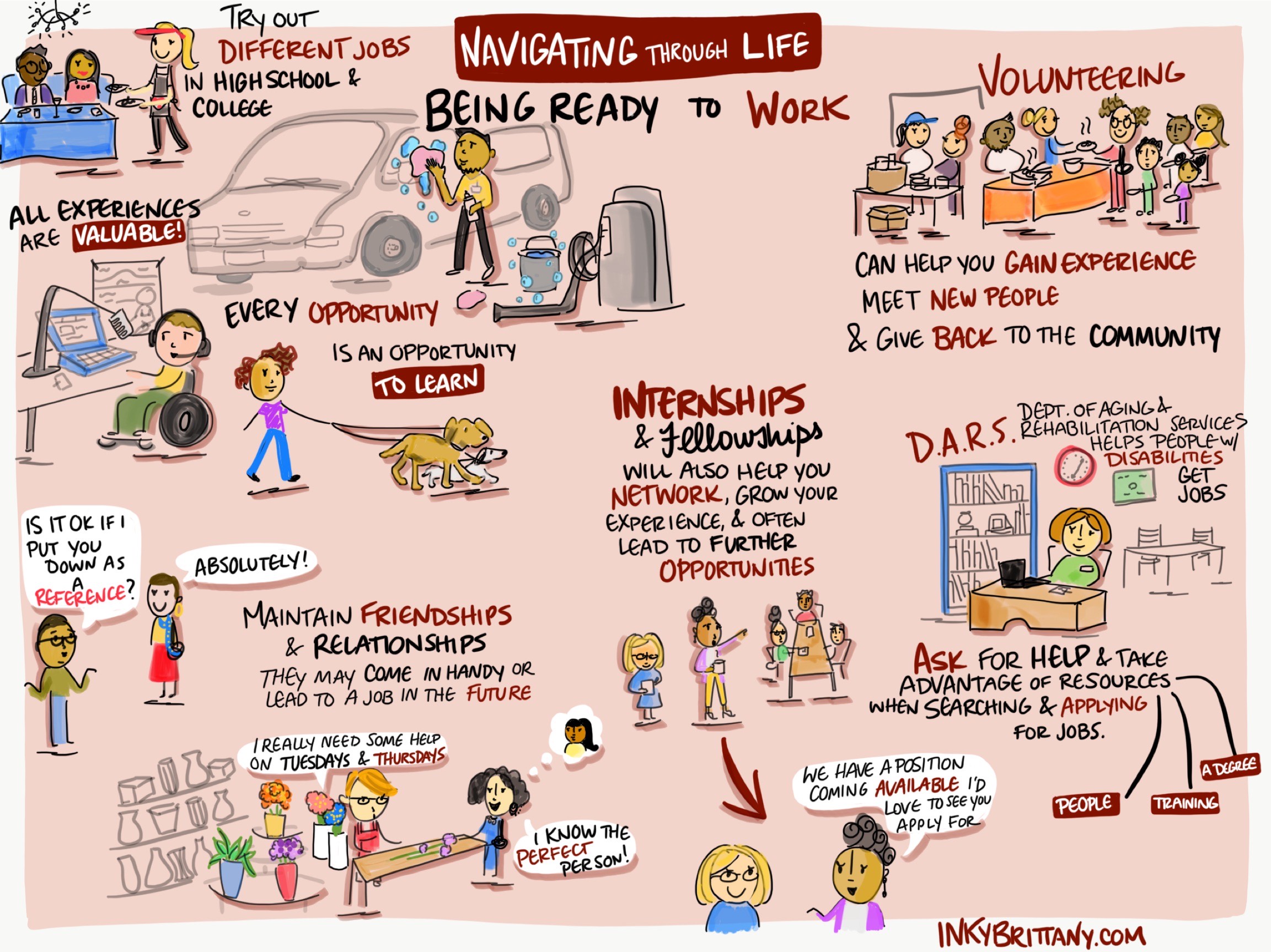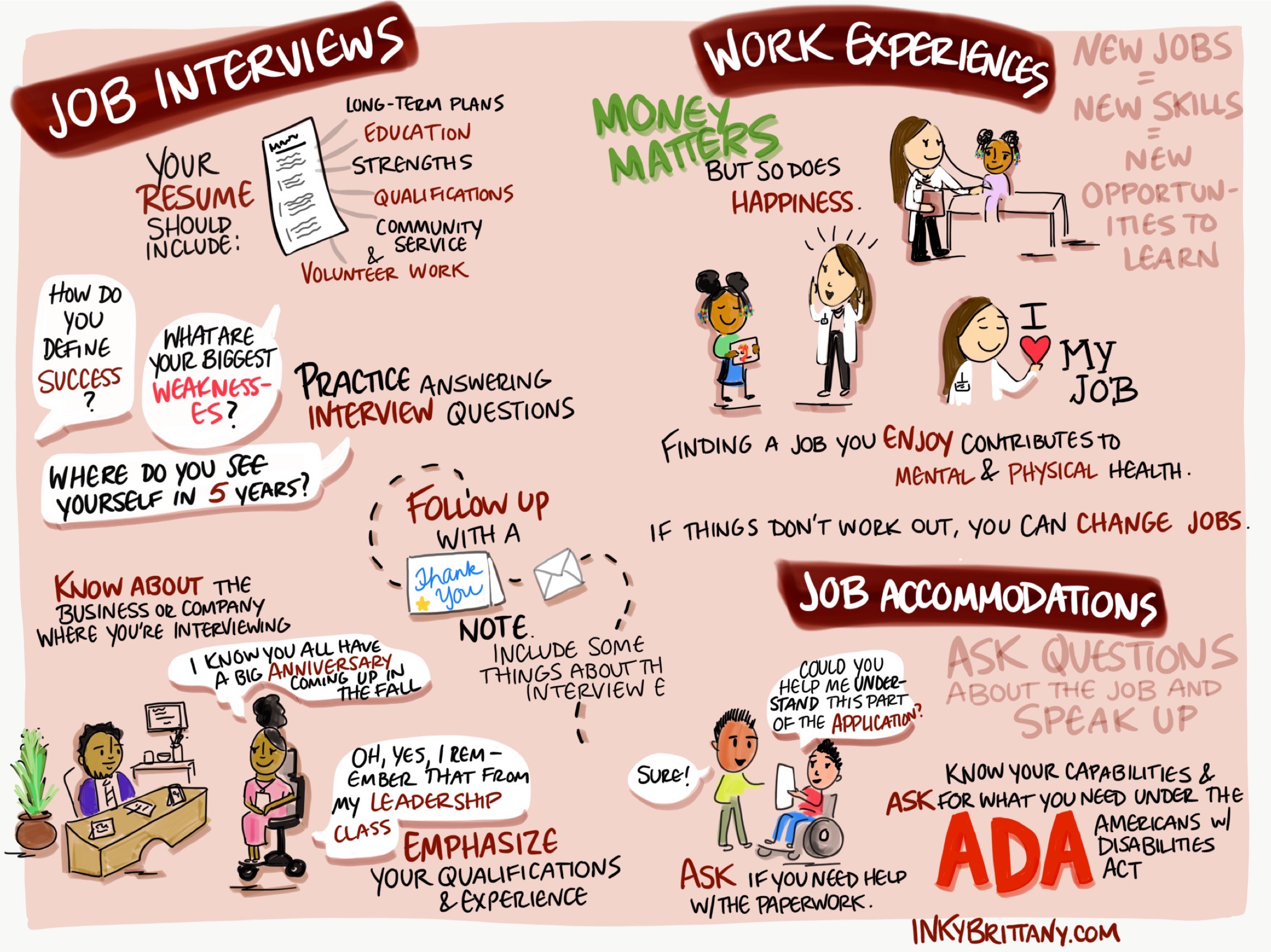Work
There are many pathways to employment, but they all start with getting to know yourself. Review some common considerations when planning for your first or next job.


This image description is for the infographic “Navigating Through Life: Being Ready to Work.” The infographic has two parts. The first part will give you information about networking, building up experience, and getting support when you apply for jobs. The second part gives specific information about job interviews, work experiences, and job accommodations. Brittany designed the graphic. You can find her at https://www.inkybrittany.com/.
The background color is pink. The text colors are different shades of pink and red. The information is scattered across the page in no particular order. From the top left, the text reads:
Try out different jobs in high school and college.
[A picture shows a waitress bringing food to a couple. Another picture shows a young man washing and vacuuming a car.]
All experiences are valuable.
[A picture shows a man in a wheelchair working at his desk on a computer. He’s wearing a microphone headset.]
Every opportunity is an opportunity to learn.
[A picture shows a girl walking two dogs on a leash.]
Maintain friendships & relationships they may come in handy or lead to a job in the future.
[A picture shows a man. He says to a woman, “Is it ok if I put you down as a reference?” The woman replies, “Absolutely!” Another picture shows two women talking. One is behind the counter at a garden store. She says, “I really need some help on Tuesdays and Thursdays.” Her friend thinks of someone to help and answers, “I know the perfect person!”]
Internships & fellowships will also help you network, grow your experience and often lead to further opportunities.
[A picture shows five people networking at a table drinking coffee. Two of them later stand together and talk. One says,“We have a position coming available I’d love to see you apply for.”]
Volunteering can help you gain experience, meet new people and give back to the community.
[A picture shows volunteers serving food to a line of hungry people.]
DARS (Dept of Aging & Rehabilitation Services) helps people with disabilities get jobs. Ask for help and take advantage of resources when searching and applying for jobs.
- People
- Training
- A Degree
[A picture shows a rehabilitation counselor sitting at her desk. She has a bookshelf full of books behind her.]
Part 2
Job interviews
Your resume should include
- Long-term plans
- Education
- Strengths
- Qualifications
- Community service
- Volunteer work
[A picture shows a crude drawing of a resume.]
Practice answering interview questions.
[Text bubbles contain 3 interview questions as examples: “How do you define success? What are your biggest weaknesses? Where do you see yourself in 5 years?” Text to the right reads.]
Know about the business or company where you’re interviewing.
[A picture shows a man interviewing a woman in a wheelchair. The woman says “I know you all have a big anniversary coming up in the fall” and “Oh, yes I remember that from my leadership class.”]
Emphasize your qualifications and experience. Follow up with a thank you note. NOTE: include some things about the interview.
[A picture shows a note and envelope.]
Work Experiences
Money matters, but so does happiness.
[A picture shows two women smiling. Another picture shows a doctor examining a girl on the examination table. A third picture shows the same doctor smiling. She says, I love my job.”]
New jobs = New skills = New opportunities to learn. Finding a job you enjoy contributes to mental & physical health. If things don’t work out, you can change jobs.
Job Accommodations
Ask questions about the job and speak up. Know your capabilities & ask for what you need under the Americans with Disabilities Act (ADA). Ask if you need help with the paperwork.
[A picture shows an employee asking his employer “Could you help me understand this part of the application?” His employer says, “Sure!”]